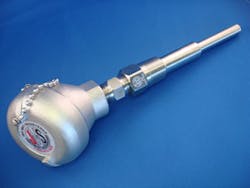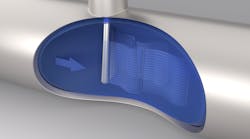Mitch Johnson is the president of JMS Southeast, a manufacturer of custom temperature sensors and thermowells based in Statesville, N.C. Mr. Johnson is a member of the ISA and serves on the ASTM E20 Committee, the ASME 19.3TW, 19.3 and 40.9 Committees. Recently, he co-authored “Practical Thermocouple Thermometry” (2nd Ed.), due out April 2012, and was named a “Control Engineering Leader Under 40.” He can be reached at [email protected].
Q: From your perspective, what are the key technology trends of the past 10-20 years in the area of temperature measurement for fluid handling applications? How has temperature measurement evolved to better meet the application needs of end-users?
A: In the world of thermocouples, the key trend has been better and more accurate sensors because of automation, more consistent production control, and widespread adoption of quality systems such as ISO 9001:2008.
This trend is mirrored in the world of RTDs (Resistance Temperature Detectors). In particular, more rugged elements for high-vibration applications have substantially improved accuracy as compared to the thin film elements made 10 to 20 years ago. Importantly, in 2009 the IEC 60751 standard established distinct accuracies and temperature ranges for thin film and wire-wound elements clarifying for both the supplier and consumer of these products the tolerances that they can expect these products to meet.
In the world of thermowells, in 2010 the ASME design standard (PTC 19.3) experienced significant and fundamental change for the first time in 34 years in response to field reports of failures and research identifying previously unidentified modes of thermowell failure. Since the ASME standard is the only standard that provides a “pass/fail” result for a thermowell design given stated process conditions, it has been incorporated into numerous standard and end-user requirements.
Thermowell design is an area of acute concern to engineers designing fluid handling applications. The consequences of an installed thermowell failure range from minor irritant to catastrophic. For the first time the ASME calculation can be applied to all common shank styles (tapered, straight and stepped). For tapered designs, which fell within the scope of the old standard, in many cases the new standard is roughly twice as conservative.
The new version (ASME PTC 19.3TW-2010) significantly improves the mechanical integrity of thermowells and allows designers to predict and avoid many sources of extreme vibration capable of causing the premature demise of installed sensors, especially RTDs.
Q: In your interactions with end-users, what are some of the common temperature-related application issues you regularly encounter when it comes to fluid handling applications? Are there any common areas of concern end-users are currently experiencing when it comes to temperature measurement in general?
A: Engineers designing a temperature measurement installation involving a thermowell are on the horns of a dilemma. On one hand, the thermowell should be designed so that its installed sensor responds quickly and accurately reflects the process temperature. The factors that tend to improve these characteristics are the same that make for a good basketball player — long, thin and fast. A long insertion length reduces conduction error. A thin shank and fast-moving process improve the accuracy and response time of the installed sensor.
On the other hand, the thermowell should be designed so that it is mechanically strong and rigid enough to avoid thermowell failure and extreme vibration. The factors that tend to support these characteristics are the opposite of the ones that support accuracy and responsiveness — short, fat and slow. The shorter and fatter the thermowell, the less prone it will be to vibration or failure. The slower the process fluid, the less stress experienced by the well. And, of course, if a thermowell fails due to vibration or stress it doesn’t do a very good job of measuring temperature.
The ASME standard is designed to resolve this universal dilemma. By application of the 19.3TW calculation, a design engineer can identify how long and thin he can make a thermowell and still satisfy the mechanical requirements of the process. The new standard offers significant improvement in this regard. There are already published accounts of failed thermowells whose failure was predicted by the 19.3TW standard when the old 19.3 standard predicted success.
Q: What are some of the core technologies/capabilities end-users should be considering today when specifying a temperature measurement device?
A: We receive inquiries from end-users and contracted engineers confronted with a requirement to apply the 19.3 ASME standard on a daily basis. The standard has grown in both length (from 4 pages to 40 pages) and complexity. Certain designs fall within the standard while others are outside its scope. Hand calculation is not the answer. End-users should have a resource to apply the 19.3TW standard. In an effort to provide a solution along this line, we have developed free software called SwiftyCalc that aims to provide end-users a tool for quickly and easily applying the standard.
On the sensing side, non-contact forms of temperature measurement have significantly improved. Consideration of IR (infrared) should now be included when surface temperature measurement is required.
Q: What are the key application variables end-users should be mindful of when specifying temperature measurement instruments?
A: On the mechanical integrity side end-users should be aware of potential causes of failure: installation, corrosion, erosion, vibration, stress, and pressure.
On the sensing side, end-users should be aware of the advantages possessed by the type of sensor they are utilizing. In high-vibration applications and cryogenic applications, thermocouples often offer an advantage over RTDs. In lower temperature applications (ex: < 900 F), standard RTDs offer a greater accuracy and do not require special extension wire.
Q: Are there any mistakes that you see end-users making on a regular basis regarding temperature measurement in general and/or temperature measurement technology selection?
A: End-users should communicate the actual requirements of their application to manufacturers rather than state a universal “maximum range,” which may not be as well suited to their application. The type K thermocouple suitable for use from -200 F to 2300 F will likely cost more and not last as long as the thermocouple that is designed to suit your actual application. This is particularly important as the cost of downtime spent typically outweighs by orders of magnitude the cost of the sensor itself.
Q: In terms of new capability and/or technologies, what can end-users look forward to in the area of temperature measurement for fluid handling systems going forward?
A: Better thermocouples, RTDs and thermowells. Better materials used in construction. More care in design on the front end, better availability and use of process condition information yielding improved run times, sensor life and accuracy.
Q: Is there anything else you would like to add?
A: Proper specification of a thermocouple, RTD or thermowell is best assisted by a fundamental understanding of how the instruments work. Temperature measurement applications are as varied in form as snowflakes and fingerprints. Memorizing and relying on “that’s the way we’ve always done it” only gets you so far. If you understand how these products work (and don’t work), you are better suited to solve new problems, improve on old solutions, and prove yourself an invaluable asset to any organization engaged in measurement of its process temperatures.




